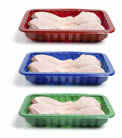
As a result of Wal-Mart’s adoption of case-ready meat packaging, and the more prevalent use of modified-atmosphere packaging over the past 10 years, many different lids and plastic trays are being used in meat packaging today as alternatives to the traditional foam trays. New tray materials are providing improved clarity, product support and protection, and ease of handling at lower costs.
“In dollar terms, foam trays are by far the leading tray type in meat, poultry and seafood packaging, although non-foam trays are expected to grow faster in coming years than foam trays,” due to a mature market, increased use of non-foam trays in case-ready packaging and growing interest in environmentally friendly packaging, say Esther Palevsky and Joe Iorillo, analysts for The Freedonia Group, an international business research group, based in Cleveland.
Trays and lids are also more prevalent in the meat aisle today because of their use in modified-atmosphere packaging (MAP), in which gases like nitrogen and carbon dioxide are injected into the package, and processed deli meats.
“This [use of MAP] will prompt heightened demand for barrier trays, which often employ barrier films, such as ethylene vinyl alcohol, laminated to the inner tray,” say Palevsky and Iorillo. “Higher performing films will see increased use as such films offer extended freshness and are important in enhancing product display.”
Plastics such as polypropylene, amorphous polyethylene terephthalate (APET) and crystallized polyethylene terephthalate (CPET) are also being increasingly used in trays.
Palevsky and Iorillo note that some tray packaging systems enable a reduction in tray height over standard lidding films, thereby reducing overall packaging, saving retail and storage space and reducing shipping costs.
Other recent innovations include self-absorbent foam trays, which are designed to soak up blood and other liquids, eliminating the need for a separate soaker pad.
In addition, sustainability and environmental concerns are prompting more use of trays designed to be biodegradable in industrial composting facilities, according to Palevsky and Iorillo.
Rigid trays are facing growing competition from flexible packaging, such as pouches and bags, because the flexible packages use less overall materials, are less likely to leak, have a longer shelf life and are less expensive to produce. Nonetheless, consumers aren’t sold on their benefits yet because their meat color isn’t as appealing as the meat from foam trays and high-oxygen MAP, says Huston Keith, principal and founder, Keymark Associates, a market research firm, based in Marietta, Ga.
“Consumers are starting to gradually accept vacuum pouches for some situations though,” he says.
Shelf life and appearance of the product contents are key concerns that will continue to be a focus of packaging improvements. For example, in case-ready packaging, high-oxygen packages can maintain the desirable red color of meat for seven to 10 days and have a shelf life of up to 12 days.
With low-oxygen packaging — in which the oxygen is virtually eliminated and gases such as nitrogen and carbon dioxide are flushed into the container — processors can boost their shelf life up to 28 days.
“However, because of the lack of oxygen, the meat has a dark purple color, which is generally considered unappealing to consumers accustomed to the ‘fresh’ red color of raw meat,” say Palevsky and Iorillo.
Another challenge packaging manufacturers will continue working on will be the ease of opening and resealability of their trays and lids, says Keith.
“Some processed-meat suppliers do an end run around these challenges by using resealable tubs, he says. “They work well, but how cost-effective they are is another question.”
In the coming years, analysts say to expect a greater use of biodegradable plastics, recyclable non-foam trays — including clear Polyethylene Terephthalate (PET) trays — and reclosable trays.
New trays and lids are providing improved clarity, support and ease of handling — at lower costs.


Report Abusive Comment